Richard Edwards, Janet Hoek, Anaru Waa – ASPIRE 2025 and University of Otago
This blog comments on the Ernst and Young (EY) report to the Ministry of Health, which evaluated tobacco excise tax increases as a strategy for achieving the Government’s Smokefree 2025 goal [1]. The report’s recommendations, including continuing annual tax excise increases (conditional on positive impacts demonstrated in enhanced monitoring) and implementing comprehensive and multi-faceted complementary measures, are highly consistent with those made in the NZ tobacco control sector’s Achieving Smokefree Aotearoa Plan (ASAP) launched a year previously [2]. The report strengthens the overwhelming case for implementing a Government-led, comprehensive strategy to achieve the Smokefree 2025 goal equitably for all peoples in Aotearoa.


